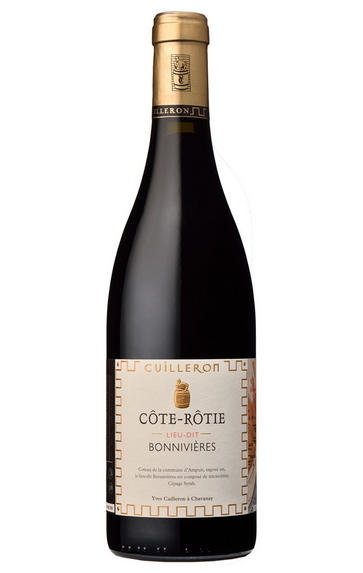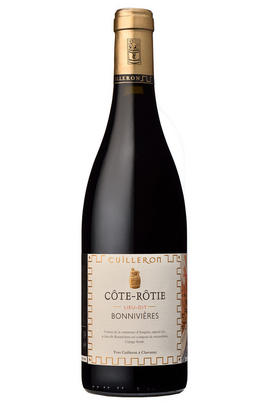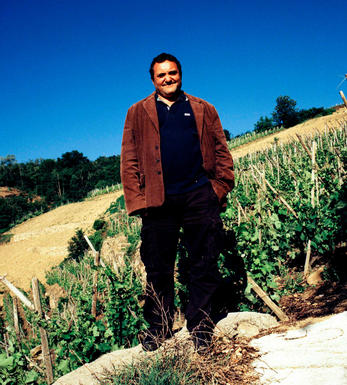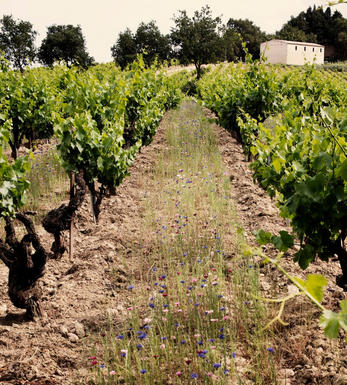
2020 Côte-Rôtie, Lieu-Dit Bonnivières, Yves Cuilleron, Rhône

Critics reviews
Dark, shimmering magenta. Displays highly perfumed black and blue fruit aromas, along with hints of vanilla, potpourri, olive and smoky minerals. Densely packed cherry, blueberry and fruitcake flavours stretch out steadily with air while taking on a suggestion of exotic spices. The mineral note repeats firmly on the vibrant and impressively long finish, which is shaped by youthfully gripping tannins.
Yves Cuilleron succeeded his uncle, Antoine, in 1987. This highly regarded domaine has been steadily expanding. With vineyard holdings of only 3.5 hectares when Yves Cuilleron assumed control, he is now pushing toward 100 hectares with vines in every Northern Rhône appellation, save for Hermitage. Cuilleron is not shy about using new oak, but the percentage has been throttled back over the last decade, which is a positive result. Cuilleron travels extensively, and his wines are now omnipresent worldwide. The entry-level Syrah bottlings here deliver excellent value and are a great and readily available introduction to the house style, which favours generous fruit and relative accessibility. That said, recent vintages have become a bit more serious, showing more restraint and structure than in the past.
Drink 2027 - 2037
Josh Raynolds, Vinous.com (December 2022)
100% Syrah. Cask sample.
Tight but elegant with dark fruit and cassis notes. Plenty of freshness so the expression is lifted as well. Firm and long on the finish. Everything is decidedly in place.
Drink 2025 - 2035
James Lawther MW, JancisRobinson.com (December 2021)
The 2020 Côte Rôtie Lieu-Dit Bonnivières is solid, with some old-school-like juicy acidity and meatiness as well as medium to full-bodied richness and depth on the palate. Showing the riper style of the vintage, it has a complex, floral perfume that includes red and blue fruits as well as notes of sandalwood, leather, and violets. It's young and unevolved and needs 4-5 years of bottle age, but it's a beautiful wine.
Drink from 2027 onward
Jeb Dunnuck, JebDunnuck.com (December 2022)
About this WINE

Domaine Yves Cuilleron
Founded by his grandfather in 1920, Yves is the third generation of Cuilleron vignerons. Since taking over in 1987, he has grown the vineyard area to 75 hectares, spanning the length of the Northern Rhône. Based in Chavanay, just south of the town of Condrieu, he makes over 40 cuvées from the range of appellations: half red, half white. The domaine is converting to organic certification, aiming to complete in 2025. In addition to the time spent in his vines and cellar, Yves is passionate about the research and revival of traditional, indigenous varieties.
We will offer two of Yves’s top Condrieu cuvées, Vernon and Verlieu. These single vineyard offerings are made like red wines, seeing 18 months ageing in demi-muids (a portion of which is new wood) and lees stirring, to be differentiated only by their vineyard - and notably the type of granite on which they grow. Complex and age-worthy, Yves cautions to drink them within seven years of vintage or to wait a further five to 10 (at risk of finding them in a closed spell).

Côte-Rôtie
Côte-Rôtie is one of the most famous of the northern Rhône appellations, with some single vineyard cuvées now selling for the same prices as First Growth Bordeaux. It is the northernmost outpost of the Syrah grape.
Côte-Rôtie translates as ‘roasted hillside’, as the south-facing slopes are exposed to the maximum-possible sunlight. Vines have been planted here since Roman times, although the appellation was only created in 1940. Today it covers 500 hectares, with 276 hectares of vineyards stretched across eight kilometres.
Phylloxera devastated vineyards in the late 1800s and Côte-Rôtie’s fortunes remained in the doldrums for another century. After the War, a farmer would receive double the price for a kilo of apricots as for a kilo of grapes, hence vineyards were grubbed up and wine production became increasingly smaller.
It has only really been recognised as a top-quality wine-producing area since the 1970s, with Guigal being the main impetus behind its revival. The two best slopes, Côte Brune and Côte Blonde, rise steeply behind Ampuis and overlook the river. The Côte Brune wines are much firmer and more masculine (the soils are clay and ironstone), whereas the Côte Blonde makes wines with more finesse and elegance due to its light, sandy-limestone soil. Both the Côte Brune and Côte Blonde vineyards rise to 1,000 feet, with a gradient of 30 to 50 degrees.
The wines are made from the Syrah grape, however up to 20 percent of Viogner can be used in the blend, adding finesse, elegance and floral characteristics to the wine. Viognier ripens more quickly than Syrah and the appellation rules stipulate that the grapes must be added to the fermentation – rather than blended later. The best Côte-Rôtie are very deep in colour, tannic and spicy, and need 10 years to evolve and develop.
There are nearly 60 official vineyards (lieux-dits); the best-known are: La Mouline, La Chatillonne (Vidal-Fleury, owned by Guigal) and La Garde (Rostaing) in Côte Blonde; La Viallière, (Rostaing), La Landonne (Guigal, Rostaing) and La Turque (Guigal) in Côte Brune.
Styles vary from heavily-extracted tannic wines which need many years to soften through to lighter, supple and less-structured wines which do not require extended bottle ageing. The most famous wines of Côte-Rôtie are Guigal’s three single-vineyard cuvées: La Mouline, La Turque and La Landonne. These are aged in new wood for 48 months, and demand for them amongst connoisseurs and collectors is significant, leading to prices sometimes comparable to Bordeaux First Growths.
Recommended producers: Guigal, Gerrin, Rostaing, Ogier, Burgaud
Best vintages: 2006, 2005, 2004, 2001, 1999, 1991, 1990, 1985

Syrah/Shiraz
A noble black grape variety grown particularly in the Northern Rhône where it produces the great red wines of Hermitage, Cote Rôtie and Cornas, and in Australia where it produces wines of startling depth and intensity. Reasonably low yields are a crucial factor for quality as is picking at optimum ripeness. Its heartland, Hermitage and Côte Rôtie, consists of 270 hectares of steeply terraced vineyards producing wines that brim with pepper, spices, tar and black treacle when young. After 5-10 years they become smooth and velvety with pronounced fruit characteristics of damsons, raspberries, blackcurrants and loganberries.
It is now grown extensively in the Southern Rhône where it is blended with Grenache and Mourvèdre to produce the great red wines of Châteauneuf du Pape and Gigondas amongst others. Its spiritual home in Australia is the Barossa Valley, where there are plantings dating as far back as 1860. Australian Shiraz tends to be sweeter than its Northern Rhône counterpart and the best examples are redolent of new leather, dark chocolate, liquorice, and prunes and display a blackcurrant lusciousness.
South African producers such as Eben Sadie are now producing world- class Shiraz wines that represent astonishing value for money.


Buying options
Add to wishlist
Description
Formerly known as “Terres Sobres” this cuvée comes from 80-year-old Serine vines grown high up an east-facing mica-schist slope above Ampuis. It is vibrant and fresh, with small, concentrated red cherry fruit on the palate, a light brush of cedar and black pepper, and a palate of silky-smooth tannins. Elegant and succulent yet poised, with a long finish.
Drink 2023 - 2030
Georgina Haacke, Wine Buyer, Berry Bros. & Rudd
wine at a glance
Delivery and quality guarantee